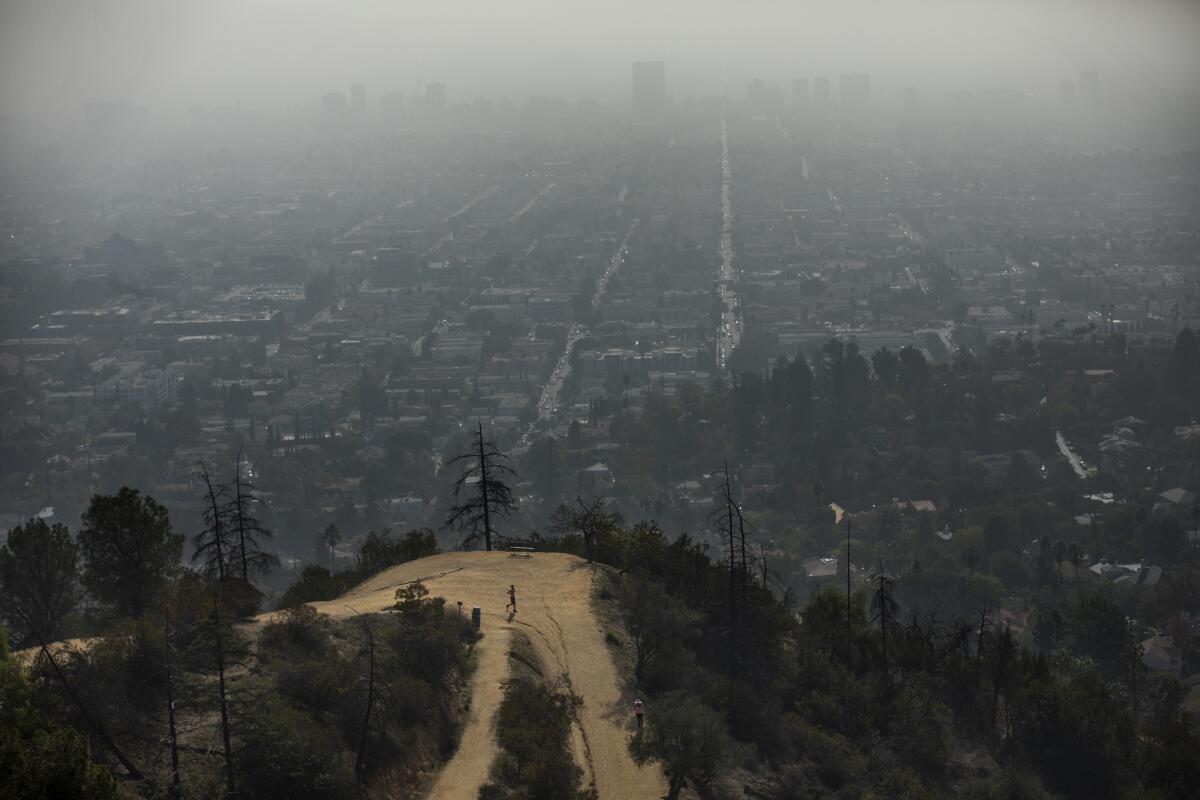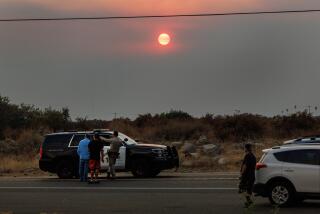Hazy skies, poor air quality: Is port congestion worsening L.A. pollution?

It hung over the Los Angeles Basin like a curtain — a veil of stagnant air that blotted out the sun and concealed both the San Gabriel Mountains and the skyscrapers of downtown L.A.
Over the first weekend of November, residents across the region were puzzled by a surprising fog that seemed to roll in from nowhere and failed to burn away like any other overcast morning. Was it wildfire smoke? Was it smog? Was it mutant June gloom?
Now, in the wake of last weekend’s mystery pall, some clean air advocates are blaming the long line of idling cargo ships anchored off the coast of Southern California for triggering the haze.
For their part, air quality regulators say the poor visibility was due to seasonal weather effects that trap air pollution over the region. They told The Times on Wednesday, however, that they would look into whether shipping was a factor.
It’s a mystery that wraps itself around chemistry, weather and international trade.
Ships often travel in and out of the ports in Southern California within a relatively short window. Ships outside the Port of Los Angeles are now waiting up to 14 days on average to enter, according to port officials. Over 100 ships are anchored and idling there, awaiting their chance to offload cargo.
Ship emissions have increased substantially when compared to the pre-pandemic era, said Chris Cannon, chief sustainability officer with the Port of Los Angeles. Anchored ship emissions went from just 1% of overall ship emissions to 42% of emissions in December 2020.
“While we have not seen any obvious emissions increases at our local [air quality] monitoring stations during these anchorage periods, we continue to carefully monitor this activity and are coordinating with local and state agencies to assess impacts,” Cannon said in a statement.
Last weekend’s haze arrived just as the port gridlock entered its second month.
“In recent times, ships usually operate using shore power when docked at the port, but they can’t do that when they are anchored offshore waiting for their turn to unload,” said Michael Kleeman, civil and environmental engineering professor at UC Davis. “I’m speculating that the fuel used by those ships while they are anchored contains enough sulfur to contribute to the regional haze problem.”
Along the coast of California, cargo ships are required to use fuel with low sulfur content.
Suzanne Paulson, professor of atmospheric and oceanic studies at UCLA, said that up until January 2020, cargo ships burned heavier fuel. Now, when those ships get near the coast of California, they’re required to shift to low-sulfur fuel. What’s unclear is whether the ships idling along California’s coast have enough of that fuel to wait out the backlog at the ports.
“This issue is unprecedented,” Paulson said. “Usually, ships come and go. The ships off the coast may be a component that contributes to the pollution we’re seeing, but a lot of it has to do with the chemistry.”
It’s a theory that Kleeman thinks could be tested by measuring the air pollution for trace amounts of “chemical fingerprints” such as vanadium, an element that can be traced back to burned sulfur fuel used by cargo ships.
The question remains up in the air, said Sarah Rees, deputy executive officer at the South Coast Air Quality Management District.
It’s not uncommon to see this type of winter pollution buildup stretching out over several days at a time, air officials said.
On Tuesday, the South Coast district extended its 24-hour ban on residential wood-burning in fireplaces, wood stoves and fire pits, in an effort to limit the amount of pollution released into the air. Of particular concern are microscopic particles known as PM2.5, which can irritate the eyes, nose and throat, and cause difficulty breathing. They can also trigger strokes, asthma attacks and heart attacks.
Starting Nov. 4, the South Coast Basin — which includes Orange, Los Angeles, Riverside and San Bernardino counties — recorded a five-day period in which the daily average of PM 2.5 exceeded the national 24-hour health standard, according to available air quality data. On Nov. 5, spikes were recorded at air quality management district stations in Compton, North Hollywood, Reseda, Upland and Ontario. In the last few years, similar periods of unhealthy air coincided with massive heat waves and wildfires burning across the region.
The current available data offer a glimpse at the trends but not whether idling cargo ships are to blame.
Rees said the cargo ships could be a contributing factor to the haze but are just one part of the tapestry of machines pumping pollution into the L.A. Basin.
“It’s a little hard to say how much,” Rees said. “Even without the ships, we would have seen high levels of [particulate matter] around this time of year.”
Ships along the coast pump emissions into Southern California that contribute to PM 2.5 levels, but they also contribute precursors that become fine particulates over time. The source of each pollutant is difficult to nail down, according to the South Coast district.
“Since these pollutants are emitted by many other sources throughout the region, it is challenging to determine how much these ship emissions contribute to measured PM2.5 concentrations,” South Coast spokesperson Nahal Mogharabi said in an email.
Weather patterns and atmospheric chemistry all influence how emissions move and affect air quality, furthering the mystery on the source of the haze.
But Adriano Martinez, senior attorney at environmental nonprofit Earthjustice, said the weather is just one factor in the pollution question.
“Whenever we see this spike in fine particulate pollution, people point to the weather,” Martinez said. “What some of that explanation misses is that impact of some of the urban areas where people live, and glosses over the specific solutions that could be pursued to curb emissions.”
There was a time when L.A. was submerged in a thick layer of smog that made people afraid to leave their homes, Martinez said. Industry regulations over the last several decades improved the quality of life for cities across the country, but there’s still much more that needs to be done, he noted. Just last year, smog remained a threat to those living in L.A., and not just for children, seniors and people with health conditions.
Kleeman said there has been tremendous progress carried out by regulatory agencies such as the South Coast district and at the federal level, but this most recent deluge of pollution is a reminder that progress is fragile.
“We’re having a little bit of a throwback to what it was like 15 to 25 years ago,” Kleeman said. “It’s a reminder of how far we’ve come and a reminder that we have to realize that these problems go away when we take the steps to make them go away.”
The National Weather Service forecasts that Santa Ana winds will return to Southern California this week. The winds are likely to blow away the haze but will also increase the chance for wildfires.
More to Read
Sign up for Essential California
The most important California stories and recommendations in your inbox every morning.
You may occasionally receive promotional content from the Los Angeles Times.











